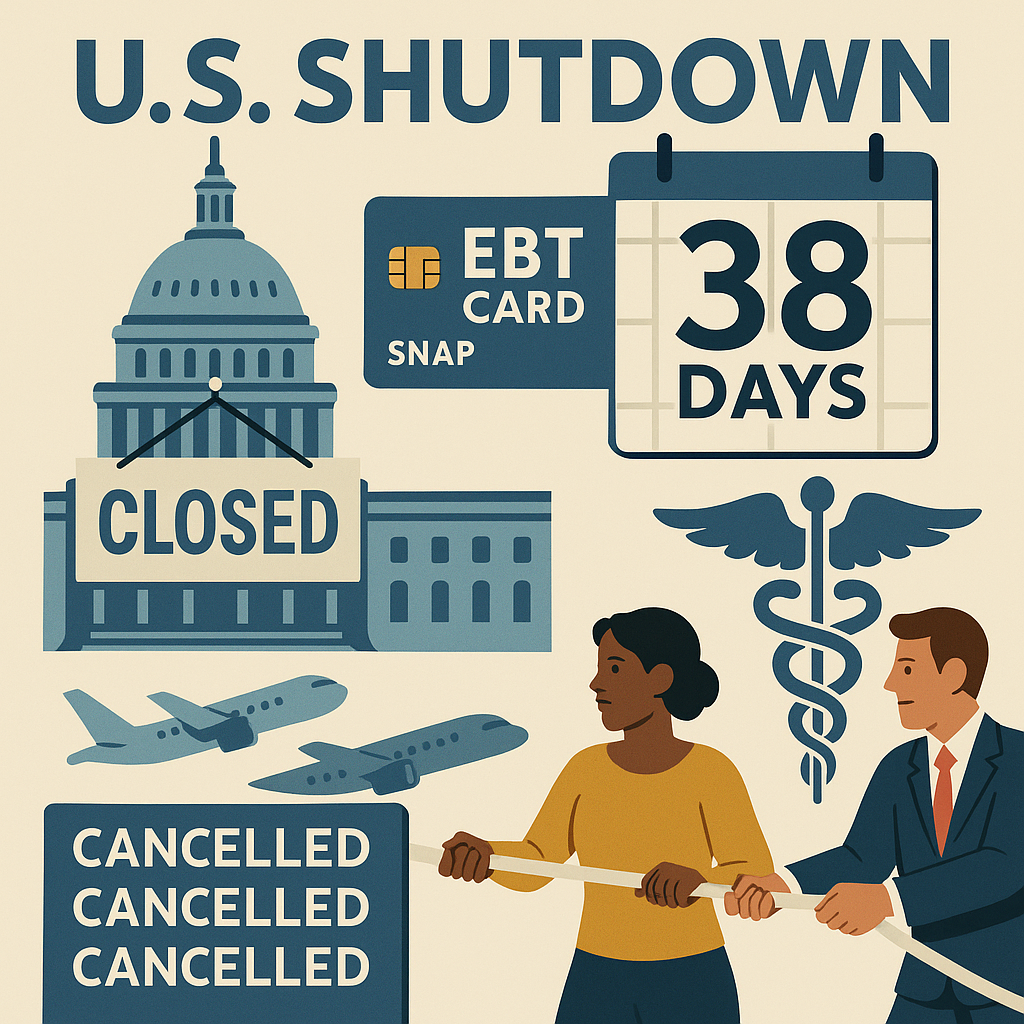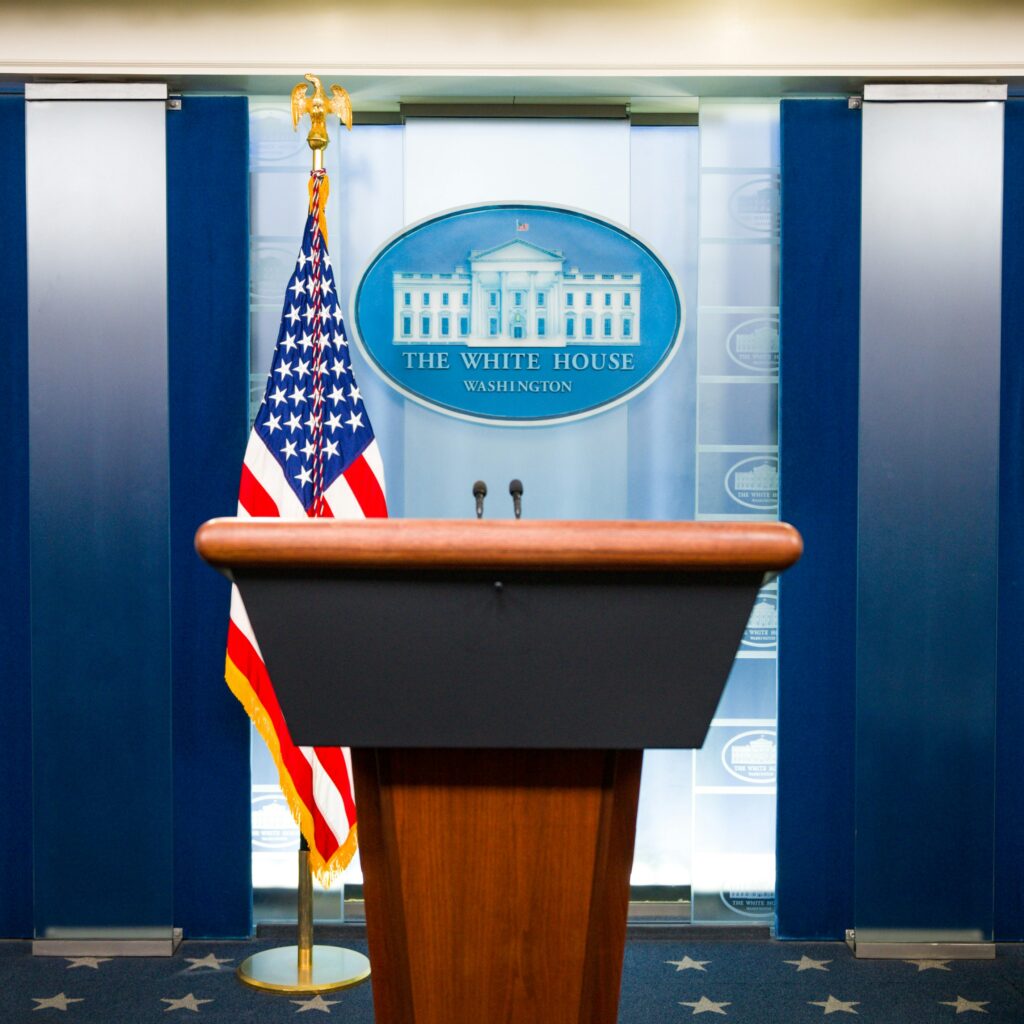U.S. shutdown 38 days into the crisis, the federal funding lapse has now surpassed every previous record and continues to metastasize across daily life: a federal court order has forced movement on SNAP (food-stamp) payments, airlines have begun canceling flights after an FAA traffic-reduction directive, and the political fight remains locked around Affordable Care Act (Obamacare) subsidies set to expire. Together, these threads explain both why the standoff remains frozen and how its costs are spilling into kitchens, airports, clinics, and balance sheets. The Guardian+2Wikipedia+2
Below is a clear briefing on where things stand, what’s changed at U.S. shutdown 38 days, and what to watch next.
1) The headline: U.S. shutdown 38 days — the longest on record
Multiple outlets now confirm the shutdown blew past the 2018–19 35-day record this week. As of Friday, it’s day 38, with the standoff rooted in Democrats’ demand to extend ACA premium subsidies before reopening, and Republicans insisting the government must reopen first. The previous record was eclipsed mid-week; as of today, the crisis is still unresolved. The Guardian+3The Guardian+3AP News+3
What’s new at U.S. shutdown 38 days: Local TV and national outlets report the Senate is again preparing to vote on a funding bill, after at least 14 failed attempts to advance House-approved legislation that omitted the ACA subsidy extension. WPMI+1

2) The safety net: court action jolts SNAP (food stamps)
With U.S. shutdown 38 days deep, a federal judge ordered the USDA to deliver SNAP benefits “as soon as possible,” a ruling that has already started to ripple through state agencies. Journalists tracking disbursements report that Wisconsin recipients received their full November benefits overnight Thursday; California, Michigan, and Oregon also began processing full payments. The administration is appealing an order to fully fund SNAP by Friday, but the immediate effect has been to restart benefits in some states that had braced for lapses. Wikipedia+1
Why this matters: SNAP supports more than 40 million people. Even a short interruption risks food insecurity spikes and local-economy shocks (grocers often see swift spending declines when benefits pause). The court-mandated payments are a stop-gap, not a solution—program administration still depends on normal appropriations.
3) The skies: FAA cuts lead to flight cancellations
At U.S. shutdown 38 days, strain on the aviation system has tipped into direct passenger impact. To relieve pressure on short-staffed facilities, the FAA ordered airlines to reduce traffic—starting at 4% today and ramping to 10% by Nov 14—covering 40 major airports. Carriers consequently began canceling flights and trimming schedules. Travelers should expect rolling disruptions, especially at peak hubs, until staffing stabilizes or the directive is lifted. Wikipedia+1
Context: Through the shutdown, air traffic controllers and TSA officers have been working without pay, straining rosters and morale. Reduced throughput is an attempt to maintain safety margins—but it spreads pain to flyers, airports, and regional economies.
4) The core dispute: Obamacare subsidies at the center
Democrats have made extension of ACA premium subsidies (set to lapse at year-end) their price to reopen the government; Republicans say reopen first, negotiate later. Newsrooms from Washington to London characterize the stalemate as an “Obamacare standoff.” The President has urged Senate Republicans to abolish the filibuster to pass a GOP funding bill alone; party leaders have resisted. Meanwhile, each failed cloture vote hardens positions and deepens service disruptions, leaving the ACA extension as the key knot to untangle. The Guardian+2AP News+2
Why ACA subsidies matter: If they expire, millions could face premium spikes on 2026 plans. Democrats argue protecting those subsidies now prevents a health-cost shock; Republicans frame the demand as leveraging a shutdown to extract unrelated policy.
5) Public-service impacts at U.S. shutdown 38 days
- Federal workforce: Roughly 900,000 furloughed; about 2 million working without pay. That means slower or suspended work at agencies like NIH, CDC, and parts of USDA, even as essential operations continue. Wikipedia
- Parks & museums: Closures and limited access have expanded (e.g., Smithsonian facilities). Wikipedia
- Aviation & transport: See FAA order above—delays and cancellations now systemic at the covered airports. Wikipedia
- Economy: Estimates vary, but the economic drag is in the billions, with CBO-style tallies cited across reports as losses mount from unpaid labor and delayed procurement. The Guardian+1
6) Politics: leverage, filibuster talk, and who’s getting blamed
At U.S. shutdown 38 days, public polling (as described in major outlets) indicates independents are increasingly blaming the White House and Republicans, while Democratic leaders—emboldened by recent state-level wins—have little incentive to fold. The President has publicly pressed for ending the filibuster; GOP senators have largely rebuffed that path. With trust eroded by unilateral executive moves alleged during the shutdown, the traditional “meet in the middle” pathway has narrowed. AP News+1
7) What a possible deal could look like
Local and national reports suggest a narrow framework: reopen government with a short-term CR while committing to negotiations on ACA subsidies and a small bundle of full-year appropriations (e.g., Agriculture/VA). Another floated concept would pair a time-limited ACA extension with offsets or policy concessions. But after 14 failed Senate votes, even modest bridges are politically costly. Still, with U.S. shutdown 38 days and growing flight disruptions, pressure for a face-saving off-ramp is intensifying. WPMI+1
8) How “SNAP order + FAA cuts + ACA fight” connect
Think of the shutdown as a three-legged stool at U.S. shutdown 38 days:
- SNAP court order keeps food benefits flowing in some states, but exposes the limits of governing by injunction. Courts can’t write appropriations. Wikipedia+1
- FAA flight reductions externalize the cost of unpaid essential workers to the public. As cancellations mount, so does political pain—especially before peak holiday travel. Wikipedia
- ACA subsidies remain the immovable object. Until leaders agree on a path—temporary extension, sequencing, or a broader bargain—the shutdown’s core incentive structure doesn’t change. The Guardian+1
Together, these forces raise the real-world stakes—food, flights, and health costs—without yet changing the math on Capitol Hill.

9) If you’re directly affected (practical notes)
- SNAP recipients: Check your state EBT portal or hotline; some states have posted full November disbursements following the court order. Expect communication lags. The Guardian
- Travelers: Monitor airline apps closely; FAA-driven capacity cuts mean schedule changes at short notice through at least Nov 14. Rebook early; know your passenger rights. Wikipedia
- Federal employees/contractors: Track agency guidance and union updates; document hours and HR communications for back-pay/claims once appropriations pass. (Back-pay for furloughed federal employees typically follows prior precedent, but contractors’ compensation varies by contract.)
10) What to watch next (48–96 hours)
- Senate floor action: Any sign of a procedural breakthrough after 14 failed tries—e.g., a narrow CR that references a date-certain ACA subsidy negotiation. WPMI
- FAA adjustments: Whether cancellations plateau as airlines right-size schedules to the 4%–10% cut or whether staffing forces sharper reductions. Wikipedia
- Appellate moves on SNAP: A stay or narrowing of the lower-court order would complicate state payment schedules; a denial would embolden more states to process full benefits. Wikipedia
- Public-opinion shifts: Prolonged flight pain could become the catalyst that prior closures were not; watch leadership statements for softening rhetoric. AP News
Bottom line
At U.S. shutdown 38 days, the crisis is no longer abstract. A SNAP court order is the only reason some families are seeing benefits. FAA-driven cancellations are the only way to keep the system safe with too few paid staff. And the Obamacare subsidy standoff remains the only politically plausible hinge to flip the shutdown. Unless leaders find a way to sequence reopening + ACA talks with minimal loss of face, expect more of the same: more missed paychecks, more canceled flights, and more stop-gap court orders trying to hold the safety net together until politics catches up.
External sources (link these at the relevant claims)
- Record duration & ACA-subsidy dispute: The Guardian; AP; Washington Post coverage as shutdown set new records (days 36–38) and outlined the Obamacare standoff at the core. The Guardian+2AP News+2
- Day-38 confirmation & failed Senate votes: Guardian live/politics reporting (38th day; 14 failed Senate attempts). The Guardian
- SNAP court order & state payments: Wikipedia’s curated timeline citing federal court rulings; Guardian live blog noting Wisconsin disbursements and CA/MI/OR processing. (Use as a pointer to the underlying court orders and AP/NYT state reports referenced therein.) Wikipedia+1
- FAA traffic-reduction directive & flight cancellations: Government-shutdown timeline entries and live reporting on the 4% → 10% cuts at 40 airports and airline cancellations. Wikipedia+1
- Ongoing Senate maneuvering: Local/NBC affiliates summarizing the day-38 posture and potential deal contours (short CR + selected full-year bills). WPMI+1

